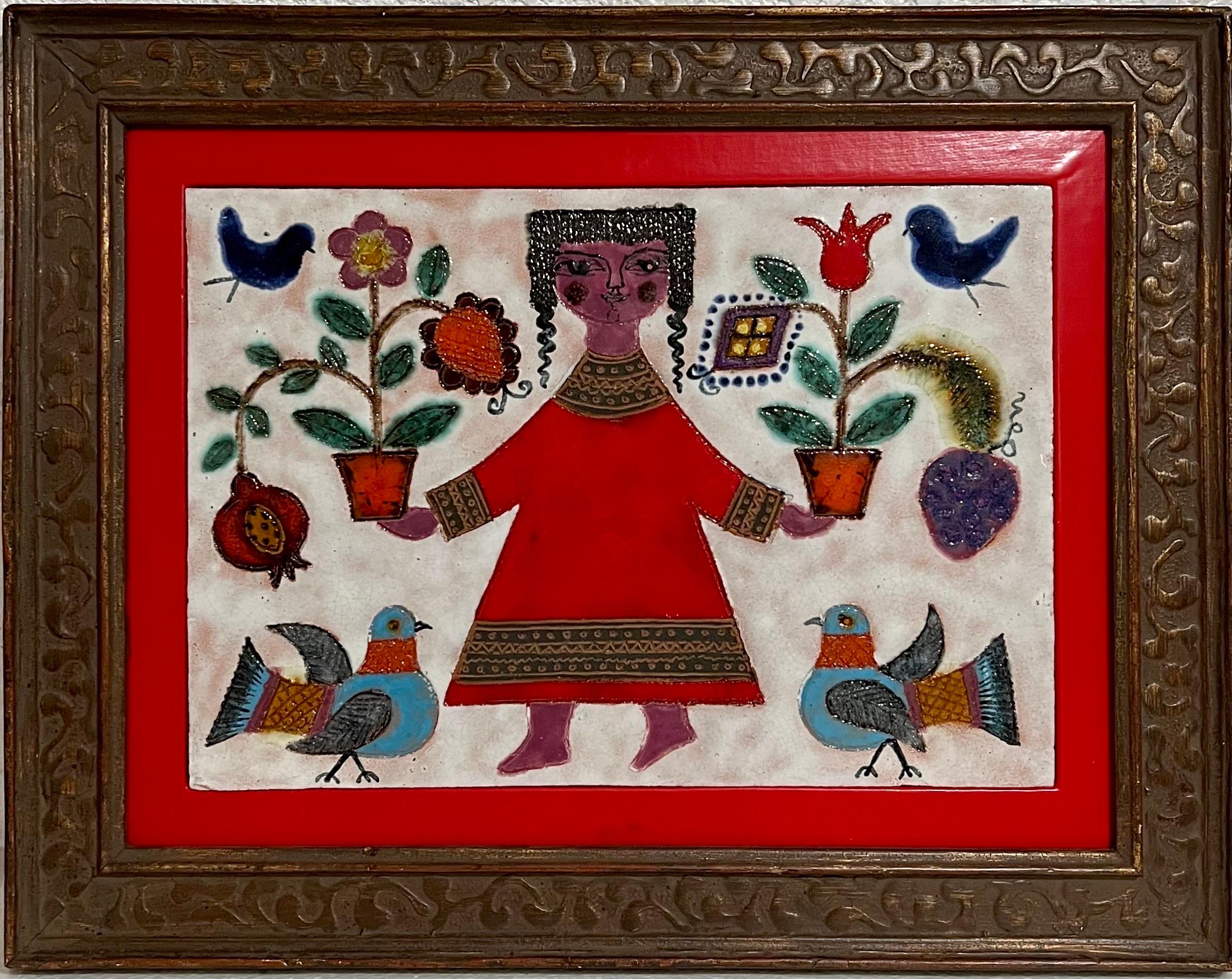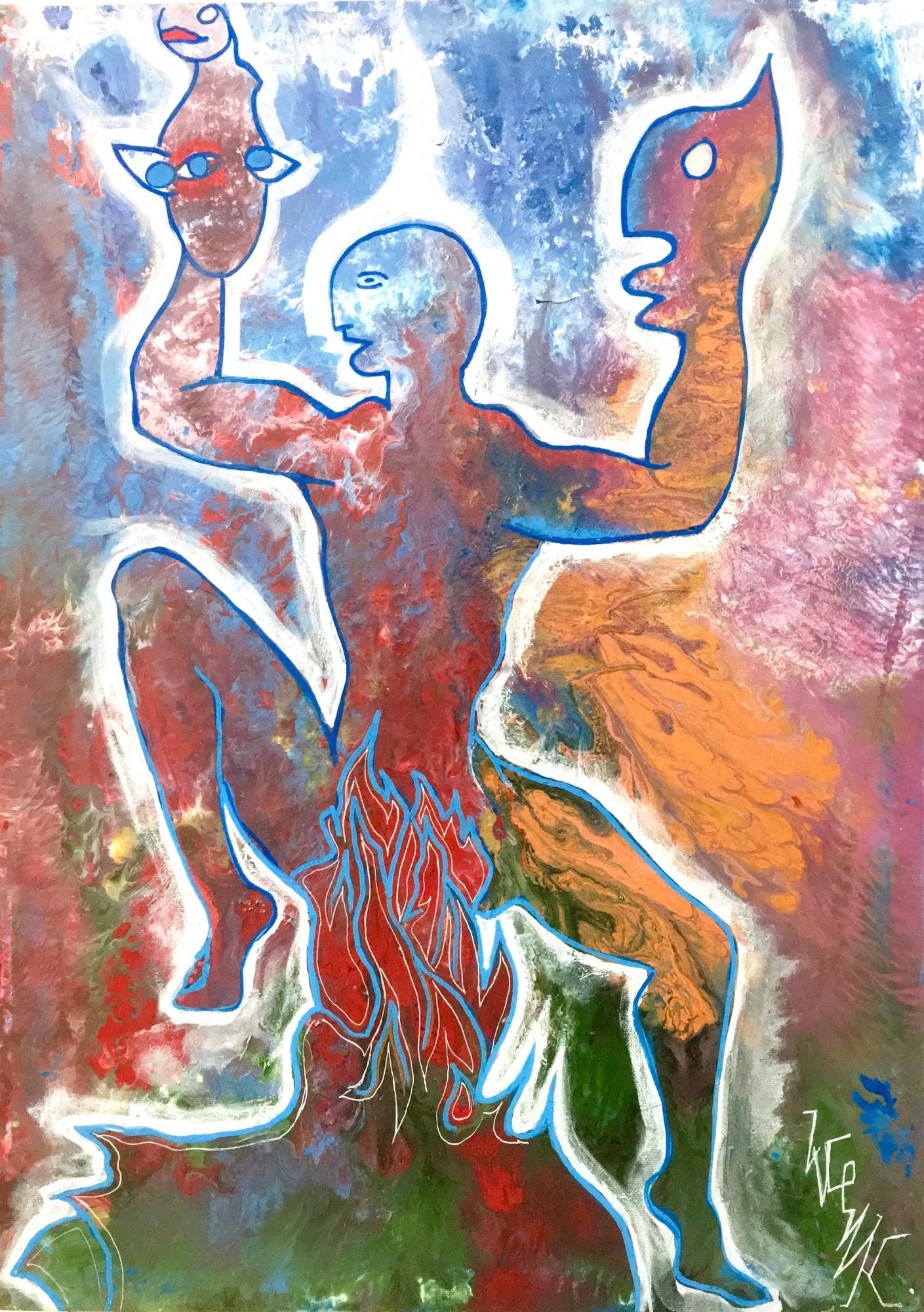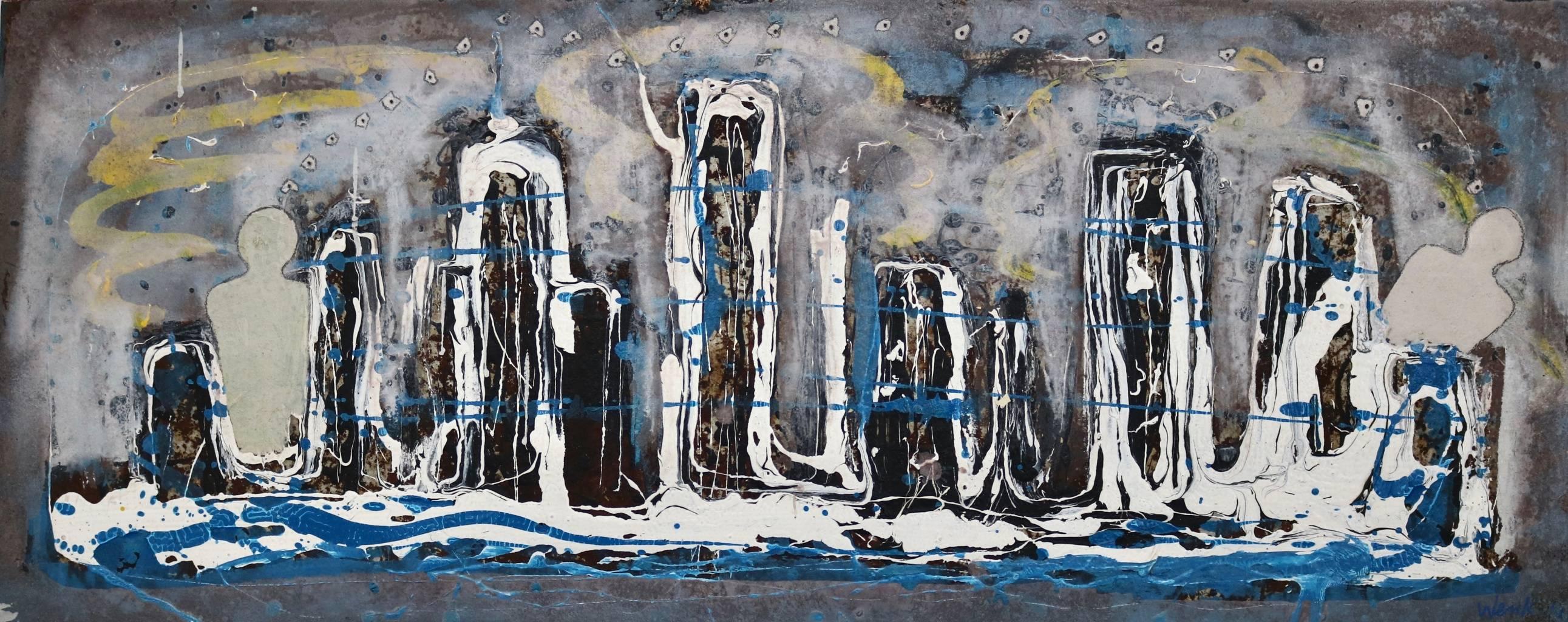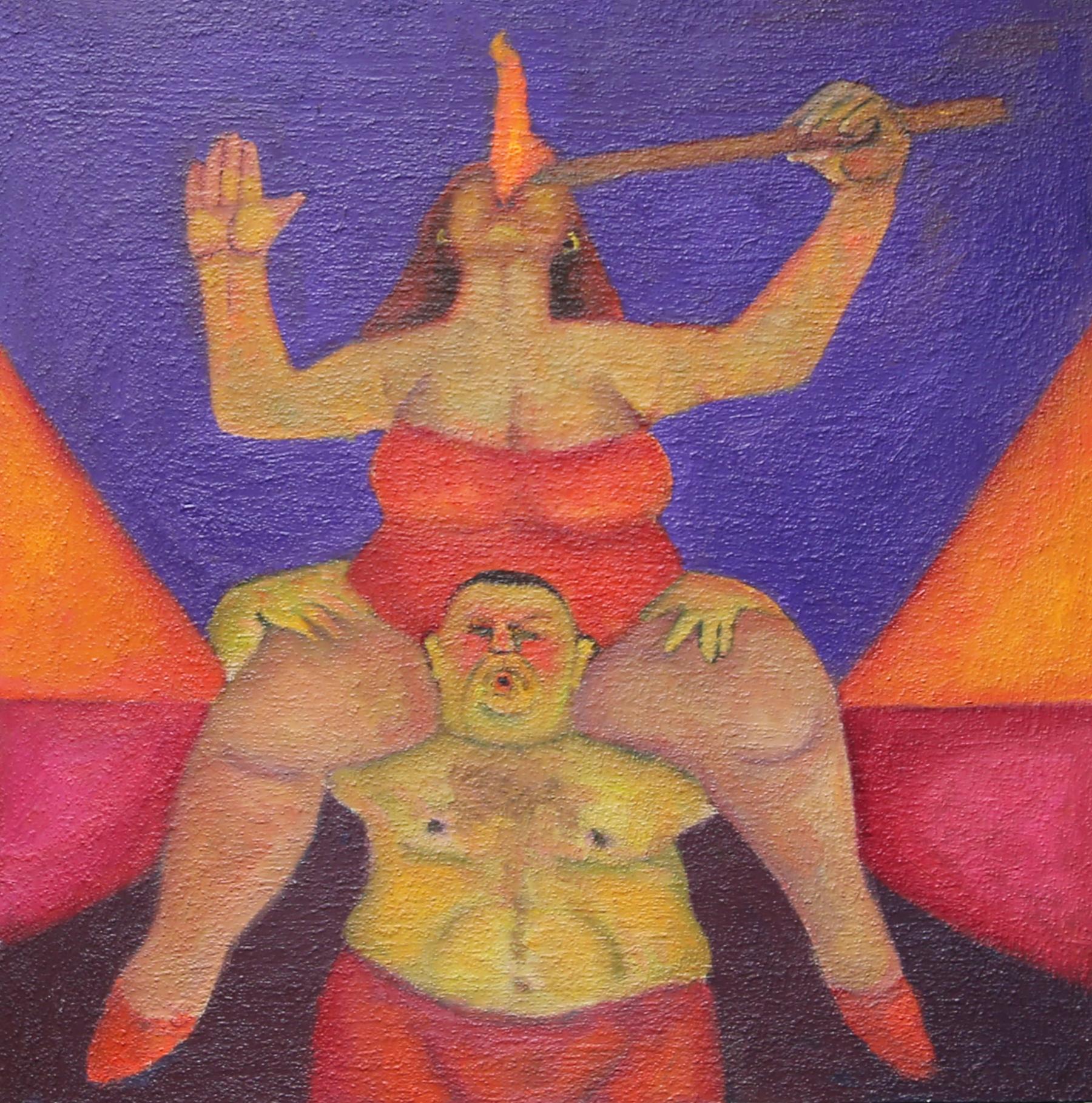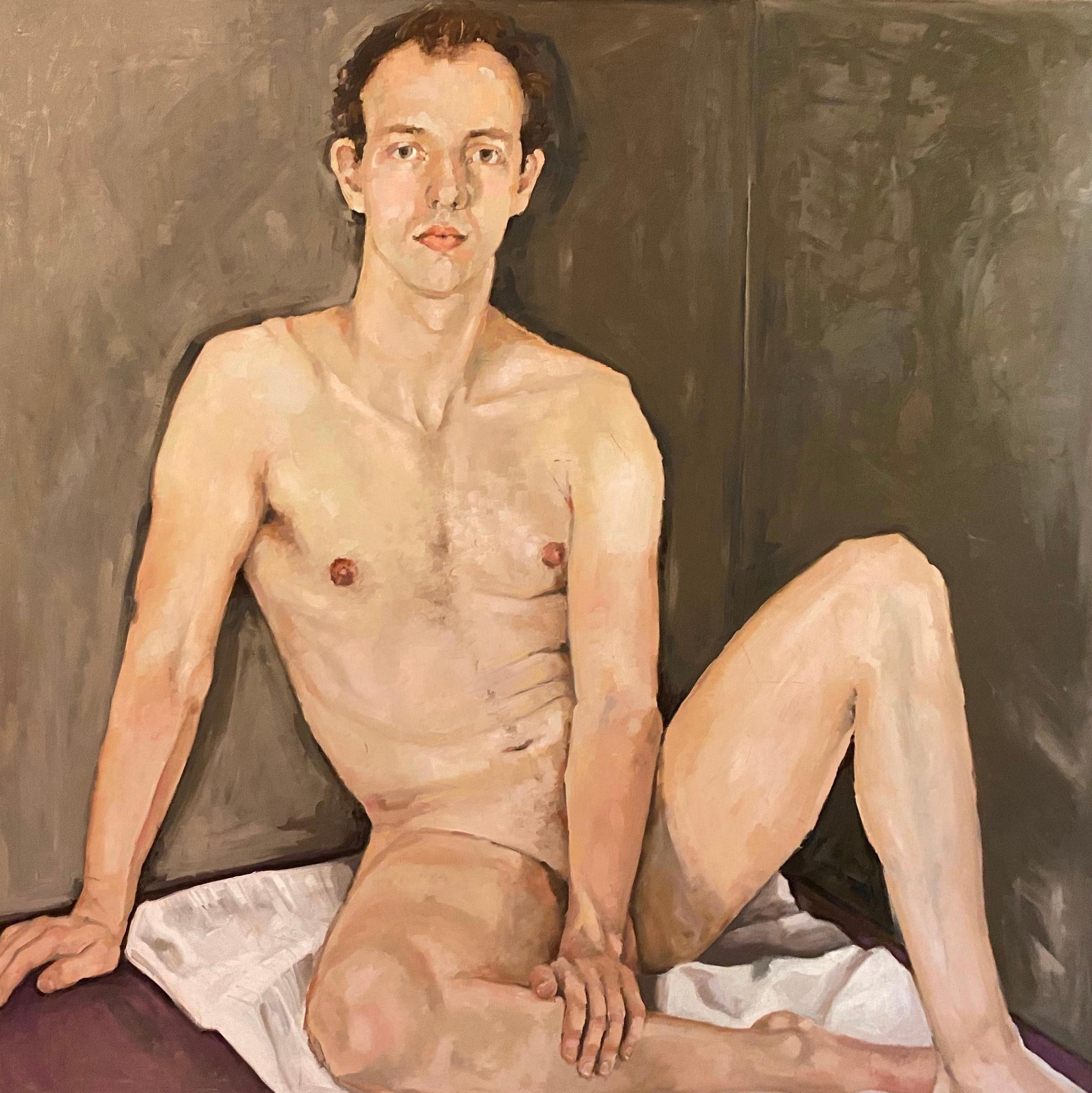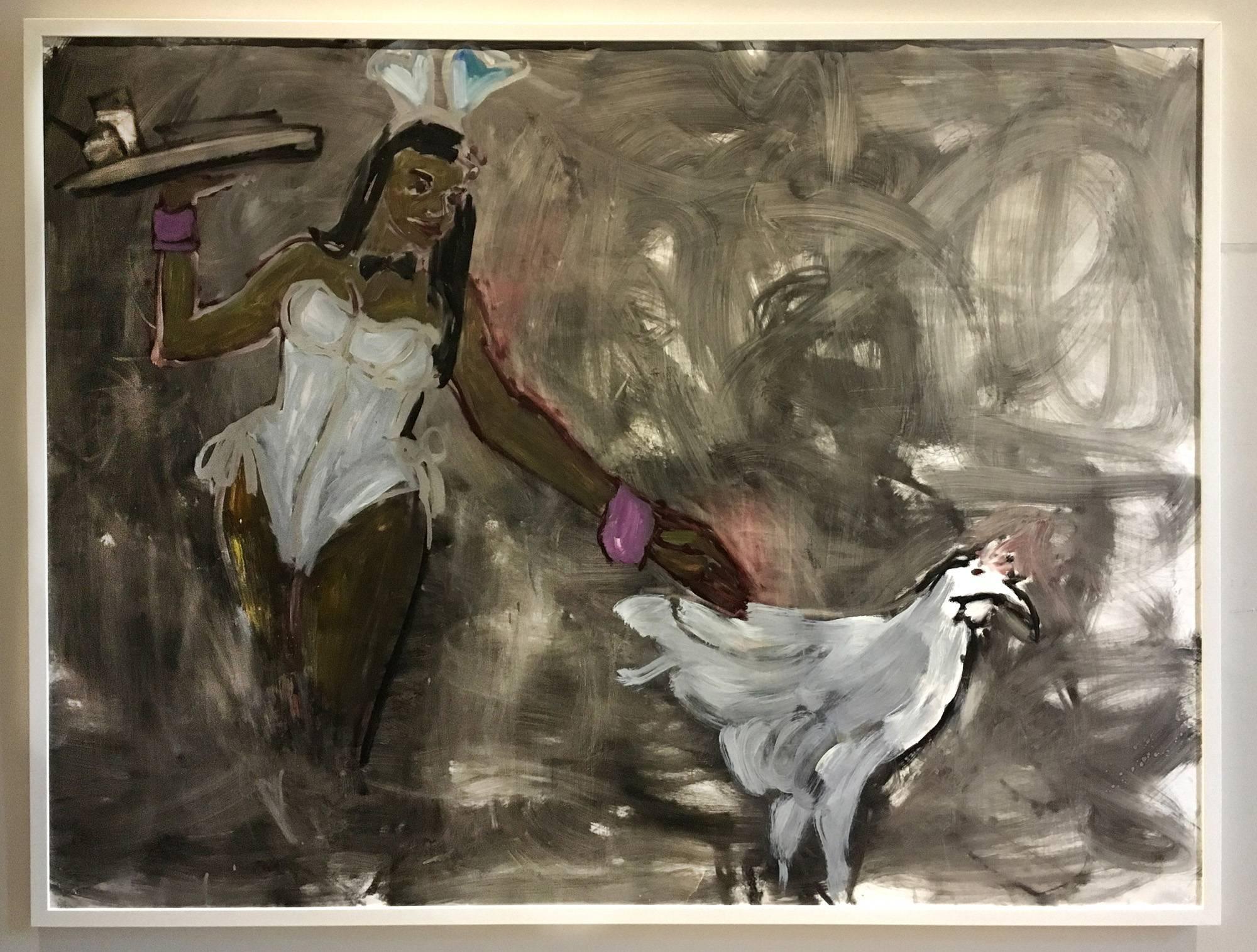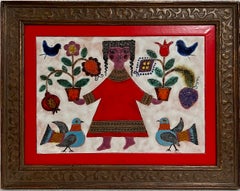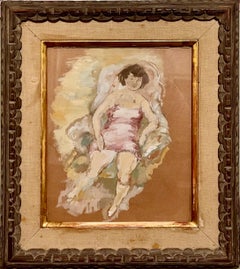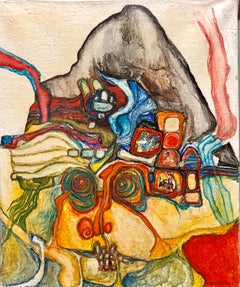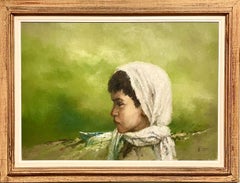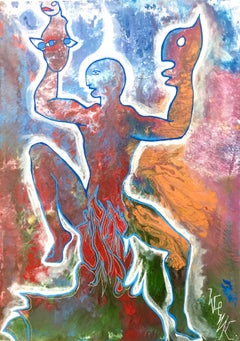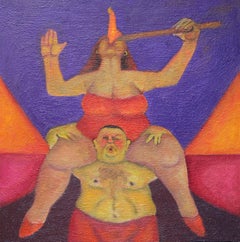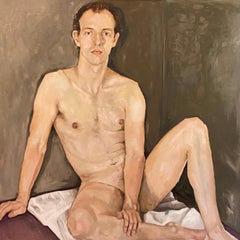Items Similar to Girl & Rooster Enamel Glazed Ceramic Plaque Israeli Artist Awret Naive Folk Art
Want more images or videos?
Request additional images or videos from the seller
1 of 11
Irene AwretGirl & Rooster Enamel Glazed Ceramic Plaque Israeli Artist Awret Naive Folk Art
About the Item
This is a rare ceramic plaque painted with enamel glaze by famed Israeli German artist Irene Awret is signed Awret Safed on the verso. the actual glazed ceramic is 10X15 inches.
Irène Awret was born to a Jewish family in Berlin called Spicker, the youngest of three children. Her mother died in 1927, when Irène was six years old. In 1937 she was forced to stop high school, due to the Nazi race laws. Because she could not continue her regular studies, her father sent her to study drawing, painting and art restoration with a Jewish painter. Among his students were a large number of German Jews who knew they would have to leave Germany within a short time and would require a profession to enable them to support themselves.
When the situation grew worse, following the Kristallnacht (the first major attack on German and Austrian Jews in November 1938), her uncle decided to move to Belgium. In 1939 the situation became even worse - her father was fired from his job and the family were forced to leave their home. As a result, Awret's father tried to send her and her sister to Belgium, with the help of smugglers. The first smuggler proved to be a double agent and they were sent back from Aachen to Berlin. Two weeks later they made a second, successful, attempt to sneak across the border.
Awret worked for a Dutch Jewish family as a maid. As she had her room and board there, she was able to save enough money to study art part-time at Brussels' Académie Royal des Beaux-Arts. A few months later Awret's father joined her and her financial situation became easier. She left her job and studied full-time, helping support herself with restoration work when it was available and by painting portraits to order.
Later, Awret found a hiding place on a farm in Waterloo with a Jewish family who were connected with the underground. In January 1943 she had to return to Brussels, living with a false identity card which stated she was a married woman with two children. Awret succeeded in renting an attic without informing the police where she was - she told her landlady that she had been forced to flee her husband because he beat her. While there, she supported herself by restoring wooden sculptures.
A Jewish informer gave her up to the Gestapo, accompanying the two Gestapo men who arrested her. Awret was able to take a bag containing food and drawing materials. She was detained in the Gestapo cellars in Brussels where she drew. Because there was nothing there to draw, she sketched her own hand (view this work). Awret was interrogated in order to reveal the hiding place of her father who was still in Brussels. The National Socialist regime was determined to persecute him, even though he had fought for Germany in World War I and been permanently disabled. They stepped up their torture and brought Awret before Hartmann, the head of the Gestapo in Brussels. When Hartmann saw her block of drawings, he asked her where she had studied art and halted the interrogation.
Awret was placed in a narrow cell and then transferred to Malines camp, which the Belgian's called Mechelen. Malines was a transit camp to Auschwitz, regularly sending 2000 people at a time. Although she arrived just before Transport No. 20, Irène Awret avoided being included. Instead she was put to work in the leather workshop, decorating broaches. While she was there, Hartmann visited the camp and spotted her: "I could have discovered where your father is hiding," he told her. When her artistic talents became known, she was transferred to the Mahlerstube (artist's workshop) where she worked producing graphics for the Germans until the end of the war. When Carol (Karel) Deutsch (whose works are now on view at Yad Vashem) was sent from Mechelen to his death with his wife, he left young Irene his paintbox. Irene also recalls seeing the great painter Felix Nussbaum and his wife being pushed into a boxcar bound for the gas, and tells of the aftermath of the famous 20th Train incident, when a young Jewish doctor armed only with a pistol and helped by two unarmed friends with a lantern ambushed one of Mechelen's Auschwitz-bound trains carrying 1,618 Jews, most of whom had fled Eastern Europe for Belgium.
Awret's job enabled her to paint and draw - mainly in pencil, but also in watercolors and oils. In the artists' workshop she met a Jewish refugee from Poland - Azriel Awret - who would later become her husband. Among the other artists in the workshop were Herbert von Ledermann-Vütemberg, a sculptor from an aristocratic family with Jewish roots, Léon Landau, and Smilowitz, who perished in the camps in the East. Irène and Azriel tried to bribe a German officer to prevent Smilowitz's deportation. Not only were they unsuccessful, but they were almost put onto the same train. Jacques Ochs was another artist with whom they became friends in the camp. Ochs, a French-born Protestant who lived in Belgium, was interned as a political prisoner. He remained in Belgium after liberation.
After the war the Awrets immigrated to Israel and made their home in Safed. They continued to work, and were instrumental in founding Safed's artists' quarter.
The Beit Lohamei Haghetaot (Ghetto Fighters' House Museum) art collection holds works donated by Awret. These date from her time in Malines camp and from her stay in Brussels after the war, when she was in the company of orphans who had hidden while their parents were sent to Auschwitz. Her highly expressive works have made their way to exhibitions at theTel Aviv Museum, the Haifa Museum of Modern Art and the Modern Art Gallery in Washington, D.C., as well as into the private collections of such individuals as Dr. Jonas Salk, Charlie Chaplin and Joan Fontaine. She wrote an autobiography "They Will Have to Catch Me First." detailing her life during the Holocaust and how art saved her.
Israel has had a Vibrant Folk Art, Naive art scene for a long time now artists like Israel Paldi, Nahum Guttman, Reuven Rubin had naive periods. The most well know of the strict naive artists are Shalom of Safed, David Sharir, Irene Awret, Gabriel Cohen, Natan Heber, Michael Falk and Kopel Gurwin.
- Creator:Irene Awret (1921 - 2014, German)
- Dimensions:Height: 22.5 in (57.15 cm)Width: 17.5 in (44.45 cm)
- Medium:
- Movement & Style:
- Period:
- Condition:wear to frame and matting. piece is in great condition.
- Gallery Location:Surfside, FL
- Reference Number:1stDibs: LU38210631032
About the Seller
4.9
Platinum Seller
Premium sellers with a 4.7+ rating and 24-hour response times
Established in 1995
1stDibs seller since 2014
1,751 sales on 1stDibs
Typical response time: 1 hour
- ShippingRetrieving quote...Shipping from: Surfside, FL
- Return Policy
Authenticity Guarantee
In the unlikely event there’s an issue with an item’s authenticity, contact us within 1 year for a full refund. DetailsMoney-Back Guarantee
If your item is not as described, is damaged in transit, or does not arrive, contact us within 7 days for a full refund. Details24-Hour Cancellation
You have a 24-hour grace period in which to reconsider your purchase, with no questions asked.Vetted Professional Sellers
Our world-class sellers must adhere to strict standards for service and quality, maintaining the integrity of our listings.Price-Match Guarantee
If you find that a seller listed the same item for a lower price elsewhere, we’ll match it.Trusted Global Delivery
Our best-in-class carrier network provides specialized shipping options worldwide, including custom delivery.More From This Seller
View AllGirl & Plants Enamel Glazed Ceramic Plaque Israeli Artist Awret Naive Folk Art
By Irene Awret
Located in Surfside, FL
This is a rare ceramic plaque painted with enamel glaze by famed Israeli German artist Irene Awret (these are generally hand signed Awret Safed on the verso. I just have not opened the frame to check) the actual glazed ceramic is 10.25 X 14.75 inches.
It depicts a girl or woman with potted plants, birds, pomegranates and other fruits and flowers in a naif, folk art style.
Irène Awret was born to a Jewish family in Berlin called Spicker, the youngest of three children. Her mother died in 1927, when Irène was six years old. In 1937 she was forced to stop high school, due to the Nazi race laws. Because she could not continue her regular studies, her father sent her to study drawing, painting and art restoration with a Jewish painter. Among his students were a large number of German Jews who knew they would have to leave Germany within a short time and would require a profession to enable them to support themselves.
When the situation grew worse, following the Kristallnacht (the first major attack on German and Austrian Jews in November 1938), her uncle decided to move to Belgium. In 1939 the situation became even worse - her father was fired from his job and the family were forced to leave their home. As a result, Awret's father tried to send her and her sister to Belgium, with the help of smugglers. The first smuggler proved to be a double agent and they were sent back from Aachen to Berlin. Two weeks later they made a second, successful, attempt to sneak across the border.
Awret worked for a Dutch Jewish family as a maid. As she had her room and board there, she was able to save enough money to study art part-time at Brussels' Académie Royal des Beaux-Arts. A few months later Awret's father joined her and her financial situation became easier. She left her job and studied full-time, helping support herself with restoration work when it was available and by painting portraits to order.
Later, Awret found a hiding place on a farm in Waterloo with a Jewish family who were connected with the underground. In January 1943 she had to return to Brussels, living with a false identity card which stated she was a married woman with two children. Awret succeeded in renting an attic without informing the police where she was - she told her landlady that she had been forced to flee her husband because he beat her. While there, she supported herself by restoring wooden sculptures.
A Jewish informer gave her up to the Gestapo, accompanying the two Gestapo men who arrested her. Awret was able to take a bag containing food and drawing materials. She was detained in the Gestapo cellars in Brussels where she drew. Because there was nothing there to draw, she sketched her own hand (view this work). Awret was interrogated in order to reveal the hiding place of her father who was still in Brussels. The National Socialist regime was determined to persecute him, even though he had fought for Germany in World War I and been permanently disabled. They stepped up their torture and brought Awret before Hartmann, the head of the Gestapo in Brussels. When Hartmann saw her block of drawings, he asked her where she had studied art and halted the interrogation.
Awret was placed in a narrow cell and then transferred to Malines camp, which the Belgian's called Mechelen. Malines was a transit camp to Auschwitz, regularly sending 2000 people at a time. Although she arrived just before Transport No. 20, Irène Awret avoided being included. Instead she was put to work in the leather workshop, decorating broaches. While she was there, Hartmann visited the camp and spotted her: "I could have discovered where your father is hiding," he told her. When her artistic talents became known, she was transferred to the Mahlerstube (artist's workshop) where she worked producing graphics for the Germans until the end of the war. When Carol (Karel) Deutsch (whose works are now on view at Yad Vashem) was sent from Mechelen to his death with his wife, he left young Irene his paintbox. Irene also recalls seeing the great painter Felix Nussbaum and his wife being pushed into a boxcar bound for the gas, and tells of the aftermath of the famous 20th Train incident, when a young Jewish doctor armed only with a pistol and helped by two unarmed friends with a lantern ambushed one of Mechelen's Auschwitz-bound trains carrying 1,618 Jews, most of whom had fled Eastern Europe for Belgium.
Awret's job enabled her to paint and draw - mainly in pencil, but also in watercolors and oils. In the artists' workshop she met a Jewish refugee from Poland - Azriel Awret - who would later become her husband. Among the other artists in the workshop were Herbert von Ledermann-Vütemberg, a sculptor from an aristocratic family with Jewish roots, Léon Landau, and Smilowitz, who perished in the camps in the East. Irène and Azriel tried to bribe a German officer to prevent Smilowitz's deportation. Not only were they unsuccessful, but they were almost put onto the same train. Jacques Ochs was another artist with whom they became friends in the camp. Ochs, a French-born Protestant who lived in Belgium, was interned as a political prisoner. He remained in Belgium after liberation.
After the war the Awrets immigrated to Israel and made their home in Safed. They continued to work, and were instrumental in founding Safed's artists' quarter.
The Beit Lohamei Haghetaot (Ghetto Fighters' House Museum) art collection holds works donated by Awret. These date from her time in Malines camp and from her stay in Brussels after the war, when she was in the company of orphans who had hidden while their parents were sent to Auschwitz. Her highly expressive works have made their way to exhibitions at theTel Aviv Museum, the Haifa Museum of Modern Art and the Modern Art Gallery in Washington, D.C., as well as into the private collections of such individuals as Dr. Jonas Salk...
Category
1950s Expressionist Figurative Paintings
Materials
Enamel
Gouache Painting Jules Pascin Hand Signed Woman in Boudoir German Expressionism
By Jules Pascin
Located in Surfside, FL
Genre: German Expressionist
Subject: Woman
Medium: gouache paint
Surface: Paper board
This is hand signed lower right.
Framed it measures 17.25 X 15.5, sheet 12 X 10
This came from a Jewish estate. there was no additional paperwork or provenance.
Julius Mordecai Pincas (March 31, 1885 – June 5, 1930), known as Pascin Jules...
Category
Early 20th Century Expressionist Figurative Paintings
Materials
Paper, Gouache, Cardboard
French Jewish Post Holocaust Abstract Painting Manner of Hundertwasser Art Brut
By Jichak Pressburger
Located in Surfside, FL
Jichak Pressburger, Painter. b. 1933, Bratislava, Czechoslovakia. A concentration camp survivior. Came to Israel aboard the ship, "The Exodus". 1964 Went to Paris. In 1979 Returned as new immigrant.
Education Tel Aviv University, B.A. in art, with Marcel Janco and Isidor Ascheim at Avni art school.
Beaux Arts, Paris with Professor Coutaud.
Itzchak Pressburger
Stays in Paris from 1963 – 1979, Resident of the “Cité des Arts” 1969-1972. Lives and works in Jerusalem since 1979.
One-Man Exhibitions
1963 Gallery Dugit, Tel-Aviv
1968 Cultural Center Enkhuizen, Netherlands
1968 Gallery Zunini, Paris (chosen by the art critic of « Opus : Jean-Jacques Lévèque)
1970 Gallery Zunini, Paris
1973 Gallery Maitre Albert, Paris. Cultural Center Verfeil sur Seye, France
1974 Gallery Maitre Albert, Paris
1976 Gallery Mundo, Barcelone
1980 Artists’ House, Jerusalem
1981 Gallery Alain Gerard, Paris
Group Exhibitions
1966 Rathaus Charlottenburg, Berlin. (The first show of Israeli painters in Germany
Artists Center of Silvarouvres, Nantes, Ffance
XXXth Salon of Finances at “l’Hotel des Monnaies”, Paris
1969 Maison de Culture, Le Havre, France
1968 Gallery Zunini, Paris (chosen by the art critic of « Opus : Jean-Jacques Lévèque)
Salon « Grands et Jeunes d’Aujourd’hui », Paris
Museum of Fine Arts, Nantes, France
Cultural Center Vitry, France
Gallery Il Giorno, Milan
Cité des Arts, Paris
1972 Salon “Grands et Jeunes d’Aujourd’hui”, Paris
Salon de Mai, Paris
1973 Städtische Galerie, Siegen, Germany
1974 Jewish Cultural Center, Paris
Publicis, Paris
1975 Réalitiés Nouvelles, Paris
1976 Salon de Mai, Paris
1977 “Perspectives Israeliennes”, Grand Palais, Paris
1981 Salon Alain Gerard, Paris
1984 Artists’ House, Jerusalem
Publication
1990 Haggadah Yom Kippour (Hebrew/French) Abraham Bliah (private edition), Paris
Acquisitions
1968 The City of Paris
1972 The State of France
The Yitzchak Pressburger artist was born in Bratislava – known for centuries by its German name of Pressburg – but the outbreak of World War II found him and his family in Prague. His father realized they had to escape from the Nazi occupiers and tried to get the family across the border into Hungary. However, they were caught near the crossing point, arrested and incarcerated overnight at the nearby railway station. The Czechs put them on a train to Hungary early the next morning. That was their first miracle in their quest for survival.
They survived with relative ease until late 1943, when the father was taken away to a forced labor camp. He subsequently died in a death march. Things became even more precarious in early 1944, when the Holocaust made its full-blown presence felt in Hungary.
“It wasn’t the Germans, it was the Hungarian Nazis who did the dirty work,” Pressburger points out. The family lived in so-called “safe houses” that were protected by Switzerland, Finland and Sweden. The havens were dismantled in late 1944, and the Pressburgers moved into one of the two Jewish ghettos in Budapest. The Nazis had found two houses with Jews, including the one where we had been, and took them all out and shot them next to the Danube. Today there is a monument by the river [called Shoes on the Danube Bank]. We should have been with the Jews who were killed by the river,” he says.
After the war, Pressburger and his siblings were farmed out to various orphanages run by the Jewish Agency, and things took a decidedly better turn.
“We finally had food to eat,” he recalls. “After a while we were put on trains that were protected by the Jewish Brigade [of the British Army], and we were sent to Austria, and then to Germany.”
“My uncle was a famous artist, and I learned a lot from him,” he says. While in Germany, Pressburger also took some lessons with a local artist.
His mother managed to get him and two of his siblings berths on the Exodus, which set sail from Marseilles for Palestine in July 1947. Pressburger was 13 at the time and clearly recalls the aborted attempt to get to the Promised Land.
“It was so crowded on the boat. This was a ship that was made to ply rivers in the United States, with a few hundred people on board, and we had over 4,500 passengers crammed in.”
As we know, the British prevented the Exodus from docking in Palestine, and the passengers were shipped – in three far more seaworthy vessels – back to France. After the French government refused to cooperate with the British, Pressburger and the others found themselves back in Germany. The teenager eventually made it here in 1948, just one month before the Declaration of Independence.
After a short furlough in Tel Aviv, during the first lull in the fighting in the War of Independence, he moved to Kibbutz Kfar Ruppin, where he worked in the cowshed. All the while he continued feverishly drawing and honing his artistic skills, which he says came in handy when he joined the IDF.
After completing his military service, which included a spell as one of the founding members of the Flotilla 13 naval commando unit, he worked in Sdom for a while at the Dead Sea Works before starting his formal arts training in earnest.
I was in the first group of students at the Avni Institute [in Tel Aviv],” he says. “There was quite a famous bunch of students and teachers like Moshe Mokadi and Isidore Ascheim and Aaron Giladi.”
In such illustrious company, one might have thought Pressburger was set to unleash his burgeoning talents on art connoisseurs across the globe, but it was a while before that happened.
Pressburger arrived in the French capital in 1964 and spent close to 15 years there, with a short interlude in Germany, before returning to Israel. His time in Paris was a professionally rewarding period of his life, and he also found love.
“[Avni Institute teacher] Yochanan Simon gave me the name and address of a French-Israeli family in Paris, but when I got to the house, a young woman opened the door and told me the family was on vacation in Israel,” he explains. Despite missing his expected hosts’ welcome, he and the German-born young lady who greeted him soon fell for each other, and romance quickly led to wedding bells. By all accounts, Pressburger did well in Europe. He secured a rare three-year berth at Cité Internationale des Arts, where artists are normally provided with accommodation and studio space for between two months and a year. He was also accepted to the prestigious Beaux Arts academy of fine arts, mounted solo exhibitions, and took part in group shows all over Europe.
One of these last was a group exhibition at Rathaus Charlottenburg in Berlin in 1966 – the first exhibition of Israeli artists in Germany after the Holocaust. When he arrived in Berlin, the lineup for the Israeli show was already signed and sealed, but somehow his work came to the attention of the German culture minister, who arranged for him to join. The Pressburgers’ year-long sojourn came to an abrupt end following an encounter he had one day while walking through the crowded Berlin streets...
Category
1960s Expressionist Abstract Paintings
Materials
Canvas, Oil
Large Israeli Expressionist Orientalist Oil Painting Draped Child Kibbutz Art
By William Weintraub
Located in Surfside, FL
William (Sunny) Weintraub, Israeli (Born 1926)
Oil on masonite
William Weintraub (He was also known as Shlomo Weintraub and nicknamed Sonny Weintraub)
Genre: Impressionist
Subject: Portrait
Medium: Oil
Surface: Canvas
Dimensions: framed 24 X 32.5 canvas 19 X 27
In an ever-changing art world that embraces one movement after the next, the timeless art of portraiture can become lost. Portraiture is often associated with the royal paintings of centuries-old French kings, European nobility, and other wealthy individuals from art history's past. However, styles like Social Realism and Dutch genre painting spotlighted...
Category
Mid-20th Century Expressionist Figurative Paintings
Materials
Canvas, Oil, Board
Gouache Watercolor Painting, Nantucket Harbor Boats American Deaf Modernist Art
By Robert Freiman
Located in Surfside, FL
Abstract harbor scene with boats, in bold, vivid colors on heavy mould made paper.
Hand signed and dated, 1980
22 X 30 not frame
Robert Freiman, deaf from birth, was born in March 1917 in New York City. He attended an oral program near his home and later transferred to the Lexington School for the Deaf when he was six. Early in his childhood, his love for drawing, painting and studying became apparent, and as an adult, he continued his studies in New York at the National Academy of Design, Pratt Institute, the Art Students League and the Parsons School of Design. In Paris, France he studied at the Ecole des Beaux Arts. Bob Freiman was especially focused on painting portraits and figures in motion in various mediums, especially the mixed-media combination of watercolor, acrylic and pen. Among his subjects were acrobats, ballet dancers, cyclists and other athletes. He as well focused on abstracts for a time, discovering new media in his works with quick brushwork and expressive movements.
In the latter part of his career, his style became abstract and surreal with images of metaphysical landscapes with architectural elements such as arches, towers, pyramids and castles floating in the air. The famed art critic Pierre Rouve wrote: “It is therefore refreshing to see them revitalized by the colourist wealth and virile handwriting of Robert Freiman, probably the best American water-colorist since John Marin. He worked in Provincetown and Nantucket and regularly exhibited there. He showed at Doll & Richards gallery of Boston alongside John Chetcuti, Lloyd Goodrich, Tod Lindenmuth, William Meyerowitz, Dwight Shepler, Elizabeth O'Neill Verner, Stanley Woodward, Andrew Wyeth, and others. His work bears the influence of the mid century school of Paris in particular Jean Carzou. He was a regular exhibitor at the Sidewalk Art...
Category
1980s Expressionist Figurative Paintings
Materials
Watercolor, Gouache, Archival Paper
Rabbi in Old Jerusalem Painting
By Isaac Frenel
Located in Surfside, FL
Yitzchak Frenel Frenkel, Israeli Master
In 1920, he established the artists' cooperative in Jaffa and an artists' studio in Herzliya. Later that year, he traveled to Paris where he studied at the École des Beaux-Arts and at the Académie de la Grande Chaumière at the studios of the sculptor Antoine Bourdelle and painter Henri Matisse. He was one of the leading Jewish artists of École de Paris. Frenkel returned to Palestine in 1925 and opened the Histadrut Art School in Tel Aviv. His students included Shimshon Holzman...
Category
20th Century Expressionist Figurative Paintings
Materials
Canvas, Oil
You May Also Like
"Figura Danzante" by Enzio Wenk, 2018 -Acrylic, Enamel, Figurative Expressionism
By Enzio Wenk
Located in Bresso, IT
Translated title: "Dancing figure".
Acrylic paint and enamel on canvas.
The artist sells the handmade, original and one-of-a-kind piece, but he reserves the right to duplicate it...
Category
2010s Expressionist Figurative Paintings
Materials
Enamel
"Il motivo di un viaggio" by Enzio Wenk, 2006- Acrylic on Metal, Urban Landscape
By Enzio Wenk
Located in Bresso, IT
Translated title: "The reason for a trip"
Acrylic on metal plate.
Category
Early 2000s Expressionist Landscape Paintings
Materials
Metal
Strongman and Fire eater circus, coney island influences colorful carnival
By Stephen Basso
Located in Brooklyn, NY
Oil on board mounted on a wooden frame suitable for immediate hanging. The board has been primed with an acrylic pumice gel giving the surface a rough texture visible from the photo...
Category
2010s Expressionist Figurative Paintings
Materials
Brass
"Seated Young Man" by Wilson - Young Man over Dark Background - Intimate Nude
By Shana Wilson
Located in Carmel, CA
Shana Wilson (Canadian, born 1966)
"Seated Young Man" 2014
Oil Paint, Wood Panel, Wire
The artist signed the back of the painting.
Shana Wilson, born in Edmonton in 1966, has carved...
Category
2010s Expressionist Nude Paintings
Materials
Wire
Beauties Series: Beauty and the Bird
By Jackie Felix
Located in Buffalo, NY
An original acrylic on paper expressionist painting by American contemporary female artist Jackie Felix.
This painting from Felix's Beauty Series was exhibited in the artist's solo ...
Category
1980s Expressionist Figurative Paintings
Materials
Silver Leaf
Girl In A Blue Chair
By Wyona Diskin
Located in Aramits, Nouvelle-Aquitaine
Wyona Diskin, American (1915 - 1991)
Girl In A Blue Chair
Acrylic on canvas partially painted over wire mesh, Unsigned. Framed.
Measurements: H 70.5 x W 49.5 x D 1.25 inches
Wyona ...
Category
1970s Expressionist Figurative Paintings
Materials
Wire
